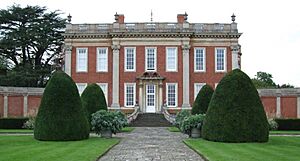Cottesbrooke Hall facts for kids
Cottesbrooke Hall is a grand old country house and estate located in Northamptonshire, England. It's considered a very important historical building, given a special "Grade I listed" status. This means it's a building of exceptional interest and needs to be protected.
Contents
Where is Cottesbrooke Hall?
Cottesbrooke Hall and its estate are about 10 miles (16 km) north of the town of Northampton. You can find it along the A5199 road, just 1 mile (1.6 km) north of the village of Creaton. The small village of Cottesbrooke is right next to the estate.
What is Cottesbrooke Hall Like?
Cottesbrooke Hall is a fantastic example of Queen Anne style architecture. It sits in a huge park with amazing views of the countryside. The house is made of brick with special stone decorations and has roofs made of lead and slate. It has seven windows across the front.
Building the Hall started in 1702 and was finished in 1713 by Sir John Langham. It looks mostly the same today, though some parts were added later around 1770-1795. The Hall is home to the Woolavington Collection, which is one of the biggest collections of paintings about sports in the world!
The Hall is surrounded by Cottesbrooke Park, which was designed in the 1700s. Inside, you'll find beautiful furniture and decorations. The gardens are also very famous. In 2000, Cottesbrooke Hall won the "Garden of the Year" Award from the Historic Houses Association and Christie's.
You can visit the building and grounds from May to September. Visiting times are limited, so it's a good idea to book ahead if you want a tour of the house. The best way to get there is to follow the signs from the A5199 road at Creaton.
The History of Cottesbrooke Hall
The Cottesbrooke estate was bought in 1635 by Sir John Langham, 1st Baronet. He was a very rich merchant from London and a Member of Parliament. The estate stayed in the Langham family for many years. In 1702, the 4th Baronet, Sir John Langham, started building the Hall you see today.
Later, Sir James Langham, 7th Baronet, was a very important person in Northamptonshire in 1767. He also represented Northamptonshire in Parliament from 1784 to 1790. In 1877, the Hall was rented for a few months to Empress Elisabeth of Austria. She used it as a base for her hunting trips.
In 1911, the Langham family had money problems and had to sell the estate to Captain Robert Bingham Brassey, who was also a Member of Parliament. The family then moved away. Since 1937, Cottesbrooke has been the home of the MacDonald-Buchanan family. In 1937-1938, they hired Lord Gerald Wellesley (who later became the 7th Duke of Wellington) to make some changes to the Hall. One big change was moving the main entrance to a different side of the house.
It's believed that Cottesbrooke Hall might have been the inspiration for "Mansfield Park." This was the country estate of Sir Thomas Bertram in Jane Austen's famous novel, Mansfield Park, which was written in 1814.
The Beautiful Gardens
The gardens at Cottesbrooke Hall today were all created in the 1900s. An architect named Robert Weir Schultz designed a special sunken garden with a pool and a covered walkway called a pergola. He also created a long paved path with different kinds of plants and old cedar trees.
A pair of old gates from the 1700s lead to rows of lime trees and a statue of a gladiator. There's also a "statue walk" with yew hedges. Along this walk, you'll find four beautiful statues by Peter Scheemakers. These statues were originally from a place called the Temple of Ancient Virtue at Stowe House and were bought in 1938.
South of the house, where the main entrance used to be, a new garden was designed in 1937 by Sir Geoffrey Jellicoe. This garden has a special pattern with low hedges, called a parterre. It features trimmed topiary shapes made of yew, lead statues, beds of 'Iceberg' roses, and pots of agapanthus flowers.


